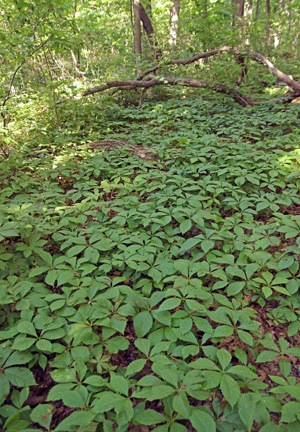
Virginia creeper is a native climber in the grape family (Vitaceae) that is especially noticeable in the fall when the leaves become colored in cool weather. The species Parthenocissus quinquefolia is found throughout eastern and central North America, from southern Canada to eastern Mexico and Guatemala. It has had numerous other scientific names; invalid synomyms include Ampelopsis hederacea var. murorum, A. quinquefolia, Hedera quinquefolia, and Vitis hederacea. Virginia creeper has many other common names including five-leaved ivy (it is not closely related to the true ivy, in the genus Hedera), five-finger, and woodbine. The closely related species, P. inserta, also called woodbine, is very similar in appearance but cannot climb smooth surfaces like P. quinquefolia can.
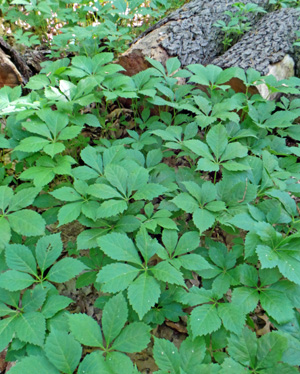
Virginia creeper grows along the ground in woodlands, often growing up trees or telephone poles on woodland borders, or in open areas such as along railroad right of ways, rocky bluffs, fence rows, banks of streams or lakes, and in disturbed habitats in both rural and urban areas. It is hardier than Boston ivy, growing in zones 3-9, so is often used where Boston or Japanese ivy (P. tricuspidata, native to Asia, zones 4-8) does not survive. The leaves of Boston ivy are 3 lobed with smoother edges and the tendrils are much shorter than on Virginia creeper.
This vigorous, deciduous woody creeper and climbing vine can grow up to 50 feet – and 20 feet in a single year – clinging to surfaces with small, branched tendrils that have strong adhesive disks on the tips to fasten onto bark or rock. The tendrils are produced on the stems opposite from the leaves.

Growing on the ground, it forms a ground cover about a foot high, with roots forming at the nodes whenever the vines come in contact with soil. The new stems are smooth and green, but eventually they turn brown and woody and finely pubescent. The plant’s tissues and sap contain microscopic, irritating needle-like calcium oxalate crystals called raphides that can cause contact dermatitis (skin irritation and blisters) in sensitive people.
The new leaves are bronze, purplish, or green tinted with red when they emerge in spring, expanding to up to 6 inches long and 2½ inches across. The alternate leaves are palmate, typically with five ovate leaflets, although leaves on young vines may have only three leaflets. The leaflets have coarsely toothed or serrated margins (at least along the top portion), pointed tips, and taper to the base. The leaves are rather variable in appearance, with some vines having broad leaflets with blunt tips and others with slender leaflets with long tips. Each compound leaf is held on a slender petiole 6-8 inches long.

The leaves are a dull green on the upper surface and light green below. The undersides may be smooth or hairs. They remain attractive through the summer, and in the autumn turn bright purple or red before falling off the vines. It is one of the earliest vines to color in the fall.
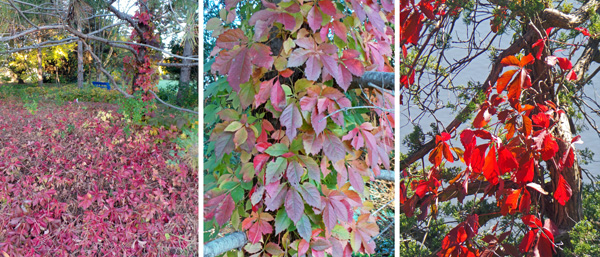
The inconspicuous flowers bloom in late spring or early summer in 4-6 inch wide clusters (panicles of compound cymes) of 50-150 flowers in the upper leaf axils, with each flower at the tip of its own peduncle. Each ¼ inch wide flower has 5 greenish white, triangular, recurved petals, 5 white stamens with large yellow anthers, and a pistil with a stout style. On each plant the flowers may be perfect, staminate only, pistillate only, or both staminate and pistillate. The flowers are pollinated by insects. Because of their small size and inconspicuous color, as well as generally being hidden by the foliage, bloom on this plant is rarely noticed.


Flowers are followed by round, fleshy, berries that mature from green to blue-black in late summer or early fall and persist on the vines. The peduncles change from green to bright orange-red or red in the fall. The hard, ¼ inch diameter berries that each contain 2 or 3 seeds that are inedible to humans (and toxic when ingested in quantity) but are an important source of food for songbirds in the winter, and deer, squirrels, skunks, and other small animals also eat them. Because of their high concentration of oxalic acid they are moderately toxic to most mammals, including humans. It self-seeds readily (or the seeds are dispersed by birds) so it can become weedy in landscaped areas.

Virginia creeper is frequently a component of woodland gardens – either planted by people or naturally dispersed there by animals – where it forms a dense ground cover even in dry shade or climbs trees. It is also often grown as an ornamental to cover walls or fences and for its attractive fall color. It can be grown on buildings as its clinging disks do not harm masonry (although pulling live vines off can damage painted surfaces; if the vine is killed first, after a while the tendrils will loosen and the vine can be removed with less damage, although a residue will remain).
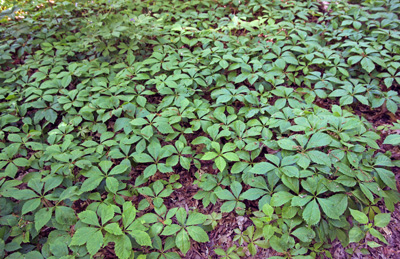
It makes a good seasonal covering on trellises, arbors, or chain link fences, and when grown on the ground it can easily disguise tree stumps, rock piles, or other eyesores. It is not well suited to mixed or perennial borders or most small gardens. Because of its prolific growth it can be a bit problematic if allowed to grow over other plants, as it smother shrubs and even trees if not managed. However, plants are very tolerant of pruning – best done in spring – and can be cut back all the way to the base if necessary.
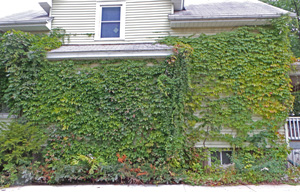
It can be used for erosion control on slopes as it attaches to the ground with adventitious roots, or try growing several plants together espaliered against a wall to provide visual interest during winter when leafless. It will attach to vertical surfaces, but is not commonly used to cover a wall or building. It also is a good plant for bonsai.
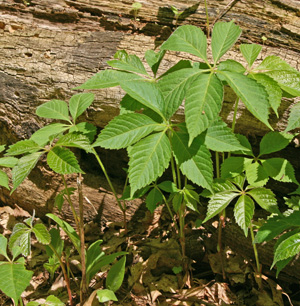
This plant is quite easy to grow and quite tolerant of a wide range of conditions. It is a good choice for shady spots where there is space to let it roam. Be sure to site it appropriately as it is so vigorous and aggressive that it may be too much for small spaces or envelop other nearby plants. It is most vigorous in full sun, but does fine in partial shade (and tolerates heavy shade), in almost any type of soil. It is drought tolerant once established, is not affected by juglone from black walnut trees, and is not highly favored by deer (although they sometimes browse the foliage), but it may be fed on by
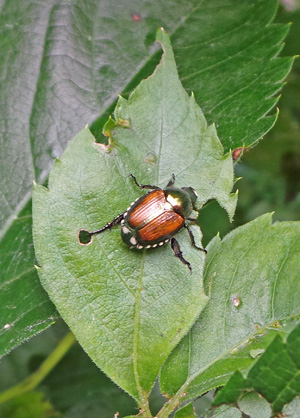
adult Japanese beetles and a few native beetles and caterpillars, especially sphinx moths. Prune at any time to shape the plant or keep it in bounds. Virginia creeper is usually grown from seed (sown in fall or spring after moist stratification), but it can also be propagated from softwood, semi-hardwood, or hardwood stem cuttings, root cuttings, or layering.

A small leafed cultivar ‘Engelmanni’ (Engelmann’s Ivy) is sometimes available. It has smaller leaves and denser growth, making it well-suited to small gardens, and is also supposed to adhere to walls better. The cultivar Star Showers® (‘Monham’) has green and white variegated foliage. ‘Variegata’ is a less vigorous cultivar with leaves variegated with yellow and white that turns pink and red in fall. Red Wall™ (‘Troki’ PPAF) by Proven Winners has brilliant red fall color, but is not recommended for planting near buildings.
Virginia creeper is sometimes mistaken for poison ivy (Toxicodendron radicans) because of its similar growth habit and size of the leaves, but is easy to distinguish by the five leaflets, whereas poison ivy always has only three leaflets and the leaflets are more variable in the number and depth of any teeth or lobes. The two plants often are found growing together.
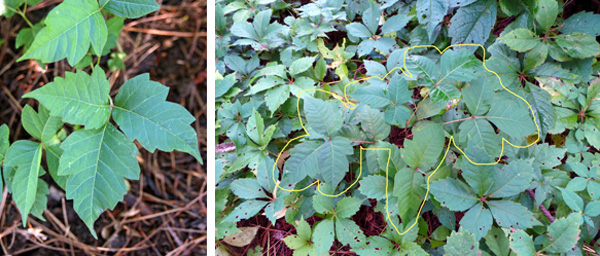
– Susan Mahr, University of Wisconsin – Madison
Latest from Wisconsin Yard & Garden
Ask Your Gardening Question
If you’re unable to find the information you need, please submit your gardening question here:





 ▶︎ Watch: Hydrangeas: Know Them and Grow Them
▶︎ Watch: Hydrangeas: Know Them and Grow Them ▶︎ Watch: Fall Bulb Planting
▶︎ Watch: Fall Bulb Planting Aster, Symphyotrichum spp.
Aster, Symphyotrichum spp. Fascinating Fasciation
Fascinating Fasciation


